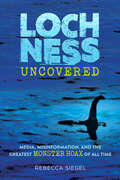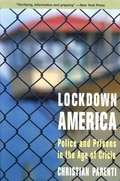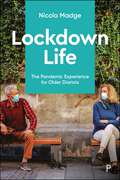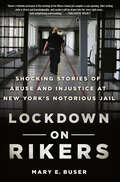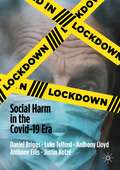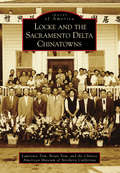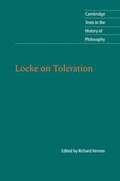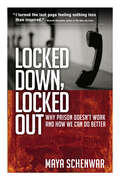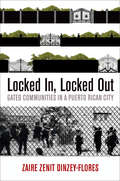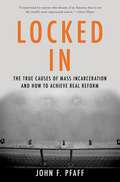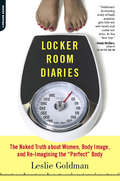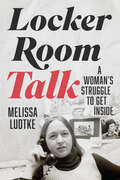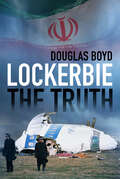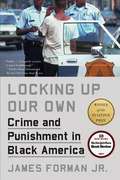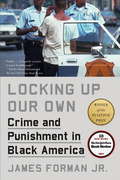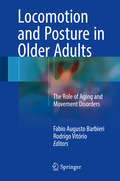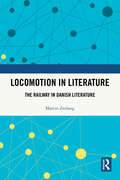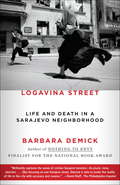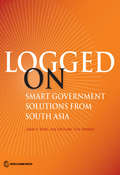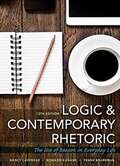- Table View
- List View
Loch Ness Uncovered: Media, Misinformation, and the Greatest Monster Hoax of All Time
by Rebecca SiegelAn extensively researched, myth-busting account of the world&’s most famous monster hoax—the Loch Ness Monster—and a cautionary tale on the dangers of misinformation.In 1934, a man was walking by a lake in the Scottish Highlands when he saw a long-necked creature swimming in the water. He grabbed his camera and snapped a photo. When the photo landed on the front page of the Daily Mail, it shattered the belief that paranormal creatures were pure fiction. But amid the monster-hunting craze, complex conspiracies soon emerged. The Loch Ness Monster became more than a mysterious sea creature—it became a phenomenon that caused people to question their assumptions and dig for the truth. Meticulously researched through primary sources and in-depth interviews with key figures, Loch Ness Uncovered is the fascinating true story of the conspiracy that sparked intrigue worldwide. Complete with archival images, an engaging narrative, and a guide to media literacy, here is a nonfiction book that will transport young readers to the thrilling world of monster mania.
Lockdown America
by Christian ParentiLockdown America documents the horrors and absurdities of militarized policing, prisons, a fortified border, and war on drugs. Its accessible and vivid prose makes clear the links between crime and politics in a period of gathering economic crisis.
Lockdown Life: The Pandemic Experience for Older Diarists
by Nicola MadgeThe COVID-19 pandemic took many by surprise when it arrived in Britain in early 2020. Daily lives changed dramatically from March with the introduction of unprecedented restrictions and lockdowns. How did people react? This book draws on the diaries of 68 men and women aged 70 and above, capturing their thoughts and experiences over the following months. Although these older diarists considered themselves among the more fortunate at the time, their entries reveal both highs and lows. There were anxieties and frustrations but also much positivity and, often, a reluctance for an over-hasty return to pre-pandemic times. Through these personal and contemporaneous accounts, the book offers a unique contribution to our understanding of the pandemic and its significance in modern social history.
Lockdown on Rikers: Shocking Stories of Abuse and Injustice at New York's Notorious Jail
by Mary E. BuserMary Buser began her career at Rikers Island as a social work intern, brimming with ideas and eager to help incarcerated women find a better path. Her reassignment to a men's jail coincided with the dawn of the city's "stop-and-frisk" policy, a flood of unprecedented arrests, and the biggest jailhouse build-up in New York City history.Committed to the possibility of growth for the scarred and tattooed masses who filed into her session booth, Buser was suddenly faced with black eyes, punched-out teeth, and frantic whispers of beatings by officers. Recognizing the greater danger of pointing a finger at one's captors, Buser attempted to help them, while also keeping them as well as herself, safe. Following her promotion to assistant chief, she was transferred to different jails, working in the Mental Health Center, and finally, at Rikers's notorious "jail within jail," the dreaded solitary confinement unit, where she saw horrors she'd never imagined. Finally, it became too much to bear, forcing Buser to flee Rikers and never look back - until now.Lockdown on Rikers shines a light into the deepest and most horrific recesses of the criminal justice system, and shows how far it has really drifted from the ideals we espouse.
Lockdown: Social Harm in the Covid-19 Era
by Daniel Briggs Justin Kotzé Anthony Lloyd Anthony Ellis Luke TelfordThis book asks whether the decision to lock down the world was justified in proportion to the potential harms and risks generated by the Covid-19 virus. Drawing on global, empirical data, it explores and exposes the social harms induced by lockdowns, many of which are 'hidden', including joblessness, mental health problems and an intensification of societal inequalities and divisions. It offers data-driven case studies on harms such as domestic violence, child abuse, the distress of being ordered to stay at home, and the numerous harms associated with the new wealth industries. It explores why some people weren't compliant with lockdown restrictions and examines the already vulnerable social groups who were disproportionally affected by lockdown including those who were locked in (care home residents), locked up (prisoners), and locked out (migrant workers, refugees). The book closes with a brief discussion on what the future might look like as we enter a post-Covid world, drawing on cutting-edge social theory.
Locke and the Sacramento Delta Chinatowns (Images of America)
by Brian Tom Chinese American Museum of Northern California Lawrence TomChinese pioneers in the Sacramento River Delta were the vital factor in reclaiming land and made significant contributions to California's agricultural industry from farming to canning. Since the 1860s, Chinese were already settled in the delta and created Chinatowns in and between the two towns of Freeport in the north and Rio Vista in the south. One of the towns, Locke, was unique in that it was built by the Chinese and was inhabited almost exclusively by the Chinese during the first half of the 1900s. The town of Locke represents the last remaining legacy of the Chinese pioneers who settled in the delta.
Locke on Toleration
by John Locke Richard Vernon Michael SilverthorneJohn Locke's Letter Concerning Toleration (1689) is one of the most widely-read texts in the political theory of toleration, and a key text for the liberal tradition. However, Locke also defended toleration more extensively in three subsequent Letters, which he wrote in response to criticism by an Anglican cleric, Jonas Proast. This edition, which includes a new translation of the original Letter, by Michael Silverthorne, enables readers to assess John Locke's theory of toleration by studying both his classic work and essential extracts from the later Letters. An introduction by Richard Vernon sets Locke's theory in its historical context and examines the key questions for contemporary political theorists which arise from this major work in the history of political thought.
Locked Down, Locked Out: Why Prison Doesn't Work and How We Can Do Better
by Maya SchenwarThrough the stories of prisoners and their families, including her own family's experiences, Maya Schenwar shows how the institution that locks up 2.3 million Americans and decimates poor communities of color is shredding the ties that, if nurtured, could foster real collective safety. As she vividly depicts here, incarceration takes away the very things that might enable people to build better lives. But looking toward a future beyond imprisonment, Schenwar profiles community-based initiatives that successfully deal with problems—both individual harm and larger social wrongs—through connection rather than isolation, moving toward a safer, freer future for all of us.
Locked In, Locked Out
by Zaire Zenit Dinzey-FloresIn November 1993, the largest public housing project in the Puerto Rican city of Ponce--the second largest public housing authority in the U.S. federal system--became a gated community. Once the exclusive privilege of the city's affluent residents, gates now not only locked "undesirables" out but also shut them in. Ubiquitous and inescapable, gates continue to dominate present-day Ponce, delineating space within government and commercial buildings, schools, prisons, housing developments, parks, and churches. In Locked In, Locked Out, Zaire Zenit Dinzey-Flores shows how such gates operate as physical and symbolic ways to distribute power, reroute movement, sustain social inequalities, and cement boundary lines of class and race across the city.In its exploration of four communities in Ponce--two private subdivisions and two public housing projects--Locked In, Locked Out offers one of the first ethnographic accounts of gated communities devised by and for the poor. Dinzey-Flores traces the proliferation of gates on the island from Spanish colonial fortresses to the New Deal reform movement of the 1940s and 1950s, demonstrating how urban planning practices have historically contributed to the current trend of community divisions, shrinking public city spaces, and privatizing gardens. Through interviews and participant observation, she argues that gates have transformed the twenty-first-century city by fostering isolation and promoting segregation, ultimately shaping the life chances of people from all economic backgrounds. Relevant and engaging, Locked In, Locked Out reveals how built environments can create a cartography of disadvantage--affecting those on both sides of the wall.
Locked In: The True Causes Of Mass Incarceration-and How To Achieve Real Reform
by John Pfaff"A succinct, powerful explanation of why much of what we think about the incarceration boom is probably wrong." --Bloomberg ViewA groundbreaking examination of our system of imprisonment, revealing the true causes of mass incarceration as well as the best path to reformIn the 1970s, the United States had an incarceration rate comparable to those of other liberal democracies-and that rate had held steady for over 100 years. Yet today, though the US is home to only about 5 percent of the world's population, we hold nearly one quarter of its prisoners. Mass incarceration is now widely considered one of the biggest social and political crises of our age. How did we get to this point? Locked In is a revelatory investigation into the root causes of mass incarceration by one of the most exciting scholars in the country. Having spent fifteen years studying the data on imprisonment, John Pfaff takes apart the reigning consensus created by Michelle Alexander and other reformers, revealing that the most widely accepted explanations-the failed War on Drugs, draconian sentencing laws, an increasing reliance on private prisons-tell us much less than we think. Pfaff urges us to look at other factors instead, including a major shift in prosecutor behavior that occurred in the mid-1990s, when prosecutors began bringing felony charges against arrestees about twice as often as they had before. He describes a fractured criminal justice system, in which counties don't pay for the people they send to state prisons, and in which white suburbs set law and order agendas for more-heavily minority cities. And he shows that if we hope to significantly reduce prison populations, we have no choice but to think differently about how to deal with people convicted of violent crimes-and why some people are violent in the first place. An authoritative, clear-eyed account of a national catastrophe, Locked In transforms our understanding of what ails the American system of punishment and ultimately forces us to reconsider how we can build a more equitable and humane society.
Locker Room Diaries: The Naked Truth about Women, Body Image, and Re-imagining the "Perfect" Body
by Leslie GoldmanI wish my thighs were smaller. "If only I could lose ten pounds. " A wake-up call for any woman who has engaged in the "if only" wishing game,Locker Room Diariesuses the unique lens of the locker room to reveal what, exactly, goes into "shaping" not just a woman's body but her body image. The locker room can be a wondrous retreat, a place to toss aside the worries of the day, but it is also where our flaws become most apparent-and where most of us can't help but wonder how we "measure up. " Often dressed in no more than a towel, Leslie Goldman spent five years talking with women of all shapes and sizes about their body image, from taut twenty-somethings to heavyset seniors. Why is it, she asks, that almost no one seems satisfied with her physique? From compulsive workouts to daily dates with the scale, from bikini waxes to body fat measurements, American women are swept up in a constant quest for the "perfect" body. Thankfully, more than one woman reveals how she halted her cycle of self-loathing and learned to like her bodyas is. Blending expert opinion with wonderfully intimate, often laugh-outloud, confidences,Locker Room Diarieswill inspire anyone who knows the highs of exercise to leave the lows of self-esteem behind-and, most especially, once and for all, to step off that scale!
Locker Room Talk: A Woman’s Struggle to Get Inside
by Melissa LudtkeWhile sportswriters rushed into Major League Baseball locker rooms to talk with players, MLB Commissioner Bowie Kuhn barred the lone woman from entering along with them. That reporter, 26-year-old Sports Illustrated reporter Melissa Ludtke, charged Kuhn with gender discrimination, and after the lawyers argued Ludtke v. Kuhn in federal court, she won. Her 1978 groundbreaking case affirmed her equal rights, and the judge’s order opened the doors for several generations of women to be hired in sports media. Locker Room Talk is Ludtke’s gripping account of being at the core of this globally covered case that churned up ugly prejudices about the place of women in sports. Kuhn claimed that allowing women into locker rooms would violate his players’ “sexual privacy.” Late-night television comedy sketches mocked her, as newspaper cartoonists portrayed her as a sexy, buxom looker who wanted to ogle the naked athletes’ bodies. She weaves these public perspectives throughout her vivid depiction of the court drama overseen by Judge Constance Baker Motley, the first Black woman to serve on the federal bench. She recounts how her lawyer, F.A.O. “Fritz” Schwarz, employed an ingenious legal strategy that persuaded Judge Motley to invoke the Fourteenth Amendment’s Equal Protection Clause in giving Ludtke access identical to that of her male counterparts. Locker Room Talk is both an inspiring story of one woman’s determination to do a job dominated by men and an illuminating portrait of a defining moment for women’s rights.
Lockerbie: The Truth
by Douglas BoydOn 21 December 1988, Pan Am Flight 103 from Frankfurt to Detroit was destroyed by a bomb, killing all 243 passengers and sixteen crew. Large sections of the aircraft, bodies and personal effects crashed onto residential areas of Lockerbie, Scotland, resulting in the deaths of a further eleven people on the ground. The psychological damage to traumatised residents would take many years to disappear; in some cases, it never did. Libyan Abdelbaset al-Megrahi is the only person to have been convicted of the crime – though few believe that he acted alone and some believe him innocent. Author Douglas Boyd presents evidence that it was Iran, not Libya, which was responsible for the attack. On 3 July 1988 (less than six months before the Lockerbie bombing), Iran Air flight 655 was in Iranian airspace on a Bandar Abbas-Dubai flight when it was shot down by missiles from the USS Vincennes sailing illegally into Iranian territorial waters. Government leader Ayatollah Khomeini decreed that blood should flow in revenge. However, this line of enquiry was quietly closed and Libya declared guilty because the White House wanted neighbouring Syria and Iran on-side for the build-up to the first Gulf War against Saddam Hussein’s Iraq. Lockerbie: The Truth at last reveals the facts about what happened on that awful night at Lockerbie.
Locking Up Our Own: Crime And Punishment In Black America
by James FormanFormer public defender James Forman, Jr. is a leading critic of mass incarceration and its disproportionate impact on people of color. In Locking Up Our Own, he seeks to understand the war on crime that began in the 1970s and why it was supported by many African American leaders in the nation’s urban centers. <p><p> Forman shows us that the first substantial cohort of black mayors, judges, and police chiefs took office amid a surge in crime and drug addiction. Many prominent black officials, including Washington, D.C. mayor Marion Barry and federal prosecutor Eric Holder, feared that the gains of the civil rights movement were being undermined by lawlessness—and thus embraced tough-on-crime measures, including longer sentences and aggressive police tactics. In the face of skyrocketing murder rates and the proliferation of open-air drug markets, they believed they had no choice. But the policies they adopted would have devastating consequences for residents of poor black neighborhoods. <p><p> A former D.C. public defender, Forman tells riveting stories of politicians, community activists, police officers, defendants, and crime victims. He writes with compassion about individuals trapped in terrible dilemmas—from the men and women he represented in court to officials struggling to respond to a public safety emergency. Locking Up Our Own enriches our understanding of why our society became so punitive and offers important lessons to anyone concerned about the future of race and the criminal justice system in this country.
Locking Up Our Own: Crime And Punishment In Black America
by James Forman Jr.Winner of the 2018 Pulitzer Prize for General Non-FictionLonglisted for the National Book AwardOne of the New York Times Book Review's 10 Best Books of 2017Former public defender James Forman, Jr. is a leading critic of mass incarceration and its disproportionate impact on people of colour. In Locking Up Our Own, he seeks to understand the war on crime that began in the 1970s and why it was supported by many African American leaders in the nation's urban centres.Forman shows us that the first substantial cohort of black mayors, judges and police chiefs took office amid a surge in crime and drug addiction. Many prominent black officials, including Washington, DC mayor Marion Barry and federal prosecutor Eric Holder, feared that the gains of the civil rights movement were being undermined by lawlessness - and thus embraced tough-on-crime measures, including longer sentences and aggressive police tactics. In the face of skyrocketing murder rates and the proliferation of open-air drug markets, they believed they had no choice. But the policies they adopted would have devastating consequences for residents of poor black neighbourhoods.A former public defender, Forman tells riveting stories of politicians, community activists, police officers, defendants and crime victims. He writes with compassion about individuals trapped in terrible dilemmas - from the men and women he represented in court to officials struggling to respond to a public safety emergency. Locking Up Our Own enriches our understanding of why American society became so punitive and offers important lessons to anyone concerned about the future of race and the criminal justice system.
Locking Up Our Own: Winner of the Pulitzer Prize
by James Forman, Jr.Winner of the 2018 Pulitzer Prize for General Non-FictionLonglisted for the National Book AwardOne of the New York Times Book Review's 10 Best Books of 2017Former public defender James Forman, Jr. is a leading critic of mass incarceration and its disproportionate impact on people of colour. In Locking Up Our Own, he seeks to understand the war on crime that began in the 1970s and why it was supported by many African American leaders in the nation's urban centres.Forman shows us that the first substantial cohort of black mayors, judges and police chiefs took office amid a surge in crime and drug addiction. Many prominent black officials, including Washington, DC mayor Marion Barry and federal prosecutor Eric Holder, feared that the gains of the civil rights movement were being undermined by lawlessness - and thus embraced tough-on-crime measures, including longer sentences and aggressive police tactics. In the face of skyrocketing murder rates and the proliferation of open-air drug markets, they believed they had no choice. But the policies they adopted would have devastating consequences for residents of poor black neighbourhoods.A former public defender, Forman tells riveting stories of politicians, community activists, police officers, defendants and crime victims. He writes with compassion about individuals trapped in terrible dilemmas - from the men and women he represented in court to officials struggling to respond to a public safety emergency. Locking Up Our Own enriches our understanding of why American society became so punitive and offers important lessons to anyone concerned about the future of race and the criminal justice system.
Locomotion and Posture in Older Adults
by Fabio Augusto Barbieri Rodrigo VitórioThis book is an attempt to advance the discussion and improve our understanding about the effects of aging and movement disorders on motor control during walking and postural tasks. Despite these activities are performed daily, there is a high requirement of motor and neural systems in order to perform both tasks efficiently. Both walking and posture require a complex interaction of musculoskeletal and neural systems. However, the mechanisms used to control these tasks, as well as how they are planned and coordinated, are still a question of discussion among health professionals and researchers. In addition, this discussion is more interesting when the effects of aging are included in the context of locomotion and the postural control. The number of older individuals is 841 million in 2015, which is four times higher than the 202 million that lived in 1950. Aging causes many motor, sensorial and neural deficits, which impair locomotion and postural control in the elderly. The severity of this framework is worsened when the aging goes along with a movement disorder, such as Parkinson disease, Chorea, Dystonia, Huntington disease, etc. Therefore, the aim of this book is to highlight the influence of different aspects on planning, controlling and performing locomotion and posture tasks. In attempting to improve current knowledge in this field, invited authors present and discuss how environmental, sensorial, motor, cognitive and individual aspects influence the planning and performance of locomotor and postural activities. The major thrust of the book is to address the mechanisms involved in controlling and planning motor action in neurological healthy individuals, as well as in those who suffer from movement disorders or face the effects of aging, indicating the aspects that impair locomotion and postural control. In addition, new technologies, tools and interventions designed to manage the effects of aging and movement disorders are presented in the book.
Locomotion in Literature: The Railway in Danish Literature
by Martin ZerlangThe invention of the locomotive changed landscapes, cityscapes, social relations, sensibilities prophesied by Hans Christian Andersen it also made huge impact on literature: on genres, themes, style. This book is about this commotion, this literary locomotion as it has been represented in Danish literature.The book explores the movements between text and context, and the interplay between literature and social history. Through the prism of the railway, the book provides an overview of Danish literary history, from writers such as Søren Kierkegaard, Georg Brandes, Henrik Pontoppidan, Johannes V. Jensen, Tove Ditlevsen, Peter Høeg. The locomotive of history is a well-known metaphor, but a historical reading of these writers also show the impact of history on this metaphor, from something extraordinary to something more ordinary. Hans Christian Andersen wrote about meeting God face-to-face on the railway. The experience of the modern commuter is closer to what Georges Perec calls the infraordinary. As reflected in the work of Peter Høeg, however, the railway also figures in the intense contemporary debates on decolonizing. The book draws on theoretical insights expressed in concepts such as chronotope, character and literary speed.This book will be of interest to students and scholars in literature studies, history, transport and mobility studies, human geography and urban studies.
Logavina Street: Life And Death In A Sarajevo Neighborhood
by Barbara DemickLogavina Street was a microcosm of Sarajevo, a six-block-long history lesson. For four centuries, it existed as a quiet residential area in a charming city long known for its ethnic and religious tolerance. On this street of 240 families, Muslims and Christians, Serbs and Croats lived easily together, unified by their common identity as Sarajevans. Then the war tore it all apart. As she did in her groundbreaking work about North Korea, Nothing to Envy, award-winning journalist Barbara Demick tells the story of the Bosnian War and the brutal and devastating three-and-a-half-year siege of Sarajevo through the lives of ordinary citizens, who struggle with hunger, poverty, sniper fire, and shellings. Logavina Street paints this misunderstood war and its effects in vivid strokes--at once epic and intimate--revealing the heroism, sorrow, resilience, and uncommon faith of its people. With a new Introduction, final chapter, and Epilogue by the author
Logged On
by Jody Zall Kusek Zubair K. Bhatti Tony VerheijenLogged On looks at mobile and smart phone technology through the lens of good government management. How will developing governments deliver goods and services that citizens care about? How will government in these countries leapfrog over traditional public management reforms to help reach out to and collaborate directly with the citizen? This book provides example after example where this has happened and how mobile technology has helped provide solutions to old problems. Our astounding revelation that mobile technology is helping to fight corruption in Pakistan, improve health delivery in Bangladesh, provide access to government by the ordinary citizen in India, and help monitor elections in Afghanistan. If this Is possible in some place in poor South Asian countries considered the most poor in the world, then how can these examples be spread to further in these counties or in other countries? Logged on Government provides a look back on conventional solutions that have mostly not worked and why mobile solutions are taking hold. The book offers a model called Smart Proactive Government based on a Feedback model being used in Punjab, Pakistan. The book also offers five solutions that are present in every successful mobile and smart phone example that the authors reviewed.
Logic And Contemporary Rhetoric: The Use Of Reason In Everyday Life (Mindtap Course List Ser.)
by Frank Boardman Nancy M. Cavender Howard KahaneLOGIC AND CONTEMPORARY RHETORIC: THE USE OF REASON IN EVERYDAY LIFE, 13th Edition, introduces you to sound reasoning using current, relevant, and stimulating examples in a witty and invigorating writing style. Combining examples from television, newspapers, magazines, advertisements, and our nation's political dialogue, this classic text brings the concepts to life and puts critical-thinking skills into a context that you will retain and use throughout your life.
Logic of Comparative Social Inquiry
by Adam Przeworski Henry TeuneThis series is designed to meet the needs of the growing cadre of scholars in comparative research. The emphasis is on cross-disciplinary studies, although works within the perspective of a single discipline are included. In its scope, the series includes books of theoretical and methodological interest, as well as studies that are based on empirical research. The books in the series are addressed to scholars in the various behavioral science disciplines, to graduate students, and to undergraduates in advanced standing. In its simplest sense, the term “comparative” refers to a method. It is appropriate, therefore, that the first book in the series deals with important issues in the methodology of comparative research. Scholars in a number of disciplines will find its poignant critique and perceptive suggestions of great interest and pertinent to their comparative endeavors.
Logic of the Powers: Towards an Impact-driven Practice of Futurist Statecraft
by Pak Nung WongWhat global future would ensure hope, justice and peace to the human mankind? In view of a fast evolving post-Covid world order, this volume explores a novel Christian post-colonial approach to global affairs. It examines the existing ‘sociology of the powers’ theoretical scheme, the debate between Christian realism and Christian pacifism, the method and practice of prophetic witnessing, to elaborate a new Christian approach to statecraft and futurology in terms of theory, methodology and ontology. This book: • Uses the COVID-19 pandemic as the background to examine why and how the pandemic has accelerated the US’s decline, and to identify the tacit game rules that contributed to the UK government’s mishandling of the pandemic; • Compares the political systems between China and the West, and engages with selected theoretical narratives from the Global South to envision an alternative ‘shared globalisation’ project; • Argues why it is important for post-colonial Christian individuals and communities to get involved in this global discussion for a new world order of complex realist interdependencies grounded on hope, social justice and peace. A fresh take on global politics and international relations, this volume will be of great interest to scholars and researchers of political science, religious studies, peace studies, theology and future studies.
Logic, Rhetoric and Legal Reasoning in the Qur'an: God's Arguments (Routledge Studies in the Qur'an)
by Rosalind Ward GwynneMuslims have always used verses from the Qur'an to support opinions on law, theology, or life in general, but almost no attention has been paid to how the Qur'an presents its own precepts as conclusions proceeding from reasoned arguments. Whether it is a question of God's powers of creation, the rationale for his acts, or how people are to think clearly about their lives and fates, Muslims have so internalized Qur'anic patterns of reasoning that many will assert that the Qur'an appeals first of all to the human powers of intellect. This book provides a new key to both the Qur'an and Islamic intellectual history. Examining Qur'anic argument by form and not content helps readers to discover the significance of passages often ignored by the scholar who compares texts and the believer who focuses upon commandments, as it allows scholars of Qur'anic exegesis, Islamic theology, philosophy, and law to tie their findings in yet another way to the text that Muslims consider the speech of God.
Logical Investigative Methods: Critical Thinking and Reasoning for Successful Investigations
by Robert J. GirodThis book describes how to use logic, reasoning, critical thinking, and the scientific method to conduct and improve criminal and civil investigations. The author discusses how investigators and attorneys can avoid assumptions and false premises and instead make valid deductions, inductions, and inferences. He explains how tools such as interview and interrogation can be used to detect deception and profile unknown individuals and suspects. The book is aimed at improving not only the conduct of investigations, but also the logical use of cognitive, analytical, documentation, and presentation tools to win cases.
